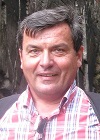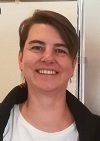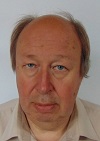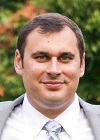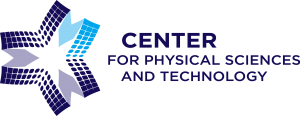Programme of the 22nd International Conference-School
“Advanced Materials and Technologies 2020”
Date: 24-28 August, 2020
Venue: Hotel “Gabija” (http://www.gabija.lt/en/)
Vytauto Str. 40, LT-00160
Palanga, Lithuania
Poster Session. August 27, Thursday,
Poster Session A (14:30 – 15:30)
Poster Session B (15:30 – 16:30)
Poster Session C (16:30 – 17:30)
Poster Session A 14:30 – 15:30
METHODS OF SURFACE ANALYSIS
| P1 |
Exchange of Optical Vortices Using Coherent Population Trapping
Hamid Reza Hamedi, Emmanuel Paspalakis, Giedrius Žlabys, Gediminas Juzeliunas, Julius Ruseckas |
| P4 |
Fly Ashes Physical Properties and Chemical Composition
Dovilė Ragauskaitė, Rasa Šlinkšienė |
| P7 |
Carbon Detection in Surface of Soils
Anta Gailisa, Katrina Laganovska, Krisjanis Smits |
| P10 |
Structures of Human Human Growth Antibodies Studied by Scanning Electrochemical Microscopy
Aura Kisieliute, Inga Morkvenaite Vilkonciene, Anton Popov, Benediktas Brasiunas, Almira Ramanaviciene, Arunas Ramanavicius |
SURFACE ENGINEERING AND NANOSTRUCTURES
| P13 |
Fabrication of Gold Nanoparticles on ITO Substrates using Nanosecond Laser and their Potential Applications
Evaldas Stankevičius |
| P16 |
SECM and EIS Characterisation of Fluorine Doped Tin Oxide Glass Application for Phospholipid Membrane Formation
Inga Gabriunaite, Margarita Poderyte, Aušra Valiūnienė |
| P19 |
Towards Application of ZnO Nanowires in Optical Biosensor Design
Vincentas Maciulis, Ieva Plikusiene, Octavio Graniel, Mikhael Bechelany, Saulius Balevicius, Vilius Vertelis, Zigmas Balevicius, Anton Popov, Arunas Ramanavicius, Almira Ramanaviciene |
| P22 |
Synthesis of ZnO Nanowires and Their Use in Alternating Current Driven Oxide Powder Electroluminescent Elements
Ēriks Vilunas, Katrīna Laganovska, Ivita Bite, Krišjānis Šmits, Edgars Butanovs |
| P25 |
Mechanical, Electrical and Morphological Characterization of CuO Nanowires Grown by a Modified Thermal Oxidation Method
Raitis Sondors, Jelena Kosmaca, Gunta Kunakova, Liga Jasulaneca, Matiss Martins Ramma, Raimonds Meija, Edijs Kauranens, Mikk Antsov, Donats Erts |
| P28 |
Low Temperature Plant Drying Method Based on the Control of the Relative Humidity
Mykyta Kovalenko, Marius Šumanas, Daniela Senkevič, Nikita Edgar Sitiajev, Andrius Dzedzickis, Vytautas Bučinskas, Inga Morkvėnaitė-Vilkončienė |
| P31 |
Characterization of Electrical and Thermoelectric Properties of Sn-doped Bi2Se3 Ultrathin Films
Andrei Felsharuk, Kiryl Niherysh, Jana Andzane, Donats Erts |
| P34 |
New Features of Mesoporous Silicon Structure
Nadzeya Khinevich, Sergey Zavatsky, Hanna Bandarenka, Sigitas Tamulevičius, Vitaly Bondarenko |
| P37 |
Temperature Behavior of Monolithic Xerogels, Doped with Nanoparticles of Erbium and Ytterbium Oxides
Iryna Sulym, Mykola V. Borysenko, Dariusz Sternik, Anna Derylo-Marczewska |
| P40 |
Synthesis, Structure and Catalytic Properties of the Ni/C, Cu/C, and Co/C Composites for Water Splitting Reaction
Mariia Galaburda, Evgeniya Kovalska, Volodymyr L. Karbivskyy, Olena I. Oranska, Zdenek Sofer, Viktor M. Bogatyrov |
| P43 |
Combination of Computer Generated and Dot-matrix Holograms for Anti-counterfeiting Employing Femtosecond Laser Ablation
Tomas Klinavičius, Tomas Tamulevičius |
ELECTRONIC AND OPTICAL MATERIALS
| P46 |
Volt-ampere Characteristics of SiC-pSi Junctions Produced with X-rays
Arvydas Juozapas Janavičius, Romualdas Purlys, Mindaugas Viliūnas, Ringaudas Rinkūnas |
| P49 |
Optical Lattices via the Coupling of Internal Atomic States
Povilas Račkauskas, Gediminas Juzeliūnas |
| P52 |
Optical and Structural Properties of ZnO Ceramics
Agnese Spustaka, Donāts Millers, Faina Muktepavela, Krišjānis Šmits, Piotr Rodnyi, Elena Gorokhova |
| P55 |
Undoped and Ga-doped ZnO Nanostructure Synthesis
Mareks Seņko, Ivita Bite, Agnese Spustaka, Donats Millers, Krišjānis Šmits |
| P58 |
meta-Substituted Benzophenones as Multifunctional Electroactive Materials for OLEDs
Rasa Keruckiene, Jonas Keruckas, Eigirdas Skuodis, Dmytro Volyniuk, Pei-His Lee, Tien-Lung Chiu, Jiun-Haw Lee, Juozas V. Grazulevicius |
| P61 |
Spectral Properties of Pseudobinary ZnMgO Systems
Rihards Ruska, Guna Krieke, Baiba Berzina, Laima Trinkler |
| P64 |
Sol-gel Synthesis of Alkali-doped Glassy Silicon Dioxide
Madara Leimane, Ivita Bite, Linards Skuja, Krišjānis Šmits, Virgīnija Vītola |
| P67 |
Dosimetric Properties of AlN-Y2O3 Ceramics
Janis Cipa, Laima Trinkler, Rihards Ruska, Baiba Berzina |
| P70 |
Broadband Chirped Mirrors with Porous Top Layer for Reduced Group Delay Dispersion Oscillations
Simas Melnikas, Lukas Ramalis, Simonas Kičas, Tomas Tolenis |
| P73 |
The Dependence of the Morphology of GdPO4 on the Synthesis Conditions
Darius Budrevičius, Andrius Pakalniškis, Ramūnas Skaudžius |
| P76 |
Subwavelength Optical Barriers for Ultracold Atoms
Edvinas Gvozdiovas, Povilas Račkauskas, Tomas Andrijauskas, Egidijus Anisimovas, Gediminas Juzeliūnas |
| P79 |
Formation and Modelling of Diffraction Periodic Micro-Structures
Andrius Žutautas, Tomas Tamulevičius, Sigitas Tamulevičius |
CERAMICS
| P82 |
Investigation of Structural Transitions in Y(3-X)PrXAl5O12 (0 ≤ X ≤ 3) System
Andrius Pakalniskis, Kristina Kristinaityte, Arunas Marsalka, Vytautas Balevicius, Ramunas Skaudzius, Aivaras Kareiva |
| P85 |
A Newly Proposed Aqueous sol-gel Synthesis for Li0.35La0.55TiO3 Ceramic
Austėja Diktanaitė, Giedrė Gaidamavičienė, Edvardas Kazakevičius, Artūras Žalga |
| P88 |
Investigation of Crystallization of Amorphous Calcium Phosphate Substituted with Smaller (Mg2+, Zn2+) and Larger (Sr2+, Ba2+) Divalent Ions
Lauryna Sinusaite, Aleksej Zarkov |
| P91 |
Low-Temperature Synthesis of Calcium Deficient Hydroxyapatite Powder
Anastasija Afonina, Linora Ruškytė, Inga Grigoravičiūtė-Puronienė, Aivaras Kareiva |
POLYMERS AND COMPOSITES
| P94 |
Manufacturing processes of Polymer Matrix Composites Using Various 3D Printing Technologies
Nabeel Maqsood, Marius Rimašauskas |
| P97 |
Application of Monte Carlo Modelling for the Assessment of Various Gafchromic Films Feasibility to Record the Dose Distribution in Non-homogeneous Media
Aleksandras Ševčik, Diana Adlienė |
| P100 |
Influence of Ester Diluents and Chain Extension on Polyurethane Viscosities
Dalia Bražinskienė, Sandra Mačiulytė, Paulina Nemaniutė, Tadas Matijošius, Svajus J. Asadauskas |
| P103 |
Characterization of the Degradation of Elastomeric Gasket by Accelerated Ageing
Chloé Simet, Marie Moreau, Karine Mougin, Florence Baly-Le Gall, Arnaud Ponche, Vincent Roucoules |
| P106 |
Thin Sheet C22E Steel FEA Analysis of Bending Stress after Laser Treatment
Oleksandr Kapustynskyi |
| P109 |
A study of Osmosis Rate through Several Proton Conducting Polymer Composite Membranes
Reinis Kaparkalējs, Einārs Sprūģis, Guntars Vaivars |
| P112 |
Tritium Absorption and Permeation Through Sulfonated poly(ether-ether ketone) (SPEEK) Membrane
Elina Pajuste, Guntars Vaivars, Liga Avotina, Andris Lescinskis, M. Halitovs, E. Sprugis, R. Kaparkalejs |
ADVANCED ENGINEERING MATERIALS
| P115 |
Investigation of Thin Perovskite La:BaSnO3 Films’ Properties Using Different Substrates
Tomas Murauskas, Mantvydas Levulis, Virgaudas Kubilius, Valentina Plaušinaitienė |
| P118 |
Influence of 3D Printed Polyamide Heels Design on the Mechanical Behaviour
Edita Gelažienė, Daiva Milašienė, Audronė Ragaišienė |
| P121 |
Fabrication and Investigation of Bioactivity Nano-Composite Obtained form PVB-co-VA-co-VAc/HA
Marzieh Rabiei, Arvydas Palevicius, Giedrius Janušas |
| P124 |
An Application of Polypyrrole for the Design of Electrochromic CO2 Sensor
Raimonda Boguzaite, Vilma Ratautaite, Karolis Treinys, Ernestas Brazys, Almira Ramanaviciene, Arunas Ramanavicius |
| P127 |
Synthesis and Investigation of Trifluoromethyl-substituted Aromatic Diamines for Optoelectronics
Ronit Sebastine Bernard, Viktorija Andruleviciene, Juozas Vidas Grazulevicius |
| P130 |
Removal of Ammonium Ions on Spent Fluid Catalytic Cracking Catalyst
Agnė Mikelionienė, Danutė Vaičiukynienė, Algirdas Radzevičius, Jūratė Mockienė |
| P133 |
Low-Temperature Synthesis of Vertically Aligned Graphene Nanosheets on Glass Substrate
Erika Rajackaitė, Rimantas Gudaitis, Domantas Peckus, Tomas Tamulevičius, Šarūnas Meškinis, Sigitas Tamulevičius |
MATERIALS FOR ENERGY APPLICATIONS
| P136 |
Beryllium Oxidation in Air at Elevated Temperatures Depending on the Relative Humidity
Rūdolfs Jānis Zabolockis, Elīna Pajuste, Līga Avotiņa, Gunta Ķizāne |
| P139 |
From fs to µs: Transient Analysis of Nonfullerene Organic Solar Cells
Rokas Jasiūnas, Huotian Zhang, Feng Gao, Vidmantas Gulbinas |
| P142 |
Evaluation of Biofuel Ash Radioactivity
Alvydė Varatinskaitė, Linas Puodžiukynas, Benas Gabrielis Urbonavičius |
| P145 |
Bi2Se3/CNT Heterostructures Synthesis for Li-ion Batteries
Vanda Voikiva, Raimonds Meija, Krisjanis Buks, Jana Andzane, Donats Erts |
| P148 |
Innovative Anode Electrodes for Na-ion Batteries
Raimonds Meija, Krisjanis Buks, Jana Andzane, Donats Erts |
| P151 |
The Evaluation of Gadolinia-doped Ceria Electrolyte for IT-SOFC Deposited by E-beam Evaporation Technique
Fariza Kalyk, Brigita Abakevičienė |
Poster Session B 15:30 – 16:30
METHODS OF SURFACE ANALYSIS
| P2 |
Site-Directed anti-CD5 Antibody Immobilization Manner via Protein G for Enhanced Detection of the CD5 by SPR Immunosensor
Elena Dauksaite, Almira Ramanaviciene, Asta Kausaite-Minkstimiene |
| P5 |
Characterization of TiO2 and Al2O3 Functional Coatings on Metal Surface
Jeļena Sušinska, Ilze Manika, Līga Bikše, Krišjānis Šmits, Ēriks Vilunas |
| P8 |
Investigation of Sculptured Thin Film Growth by Optical Monitoring
Gabija Petrauskaitė, Lina Grinevičiūtė, Lukas Ramalis, Tomas Tolenis |
SURFACE ENGINEERING AND NANOSTRUCTURES
| P11 |
Effect of Laser Alloying on Surface Properties of Additively Manufactured Maraging Steel 300 Part
Kęstutis Bučelis, Jelena Škamat, Olegas Černašėjus |
| P14 |
Electroless Plating of Continuous Platinum Layer
Ina Stankevičienė, Aldona Jagminienė, Loreta Tamašauskaitė-Tamašiūnaitė, Eugenijus Norkus |
| P17 |
Bioanalytical Device Based on the Metallurgical Aluminum Surface
Tomas Sabirovas, Eimantas Zolubas, Aušra Valiūnienė |
| P20 |
Analysis of Ultrafast Relaxation Processes of the Silver Nanoparticles in Colloid after Laser Modification
Gerda Klimaitė, Domantas Peckus, Mantas Mikalkevičius, Asta Tamulevičienė, Tomas Tamulevičius, Sigitas Tamulevičius |
| P23 |
Precise Thickness Porous Anodic Aluminium Oxide for Optical Sensors
Karlis Lazdovskis, Raimonds Poplausks, Uldis Malinovskis, Donats Erts, Juris Prikulis |
| P26 |
Growth of Aluminium Nanowires on Scratched Surface of Black Aluminium Films during Thermal Annealing
Marina Romanova, Stanislav Cichon, Yuri Dekhtyar, Premysl Fitl, Joris More-Chevalier, Michal Novotny, Lenka Volfová |
| P29 |
Fabrication and Properties of Carbon Nanotube Scaffolds for Application in Flexible Thermoelectrics
Aleksandrs Dutovs, Krisjanis Buks, Jana Andzane, Donats Erts |
| P32 |
Fabrication of Suspended Bi2Se3 Nanoribbon Structures for Characterization and Device Applications
Liga Jasulaneca, Matiss Martins Ramma, Raitis Sondors, Raimonds Meija, Edijs Kauranens, Donats Erts |
| P35 |
Optical Sensor Based on Gold Nanoparticle Formation for Reducing Sugar Determination
Benediktas Brasiunas, Anton Popov, Arunas Ramanavicius, Almira Ramanaviciene |
| P38 |
Surface Renewal of Aluminium Single-crystal Electrodes using Chemical Etching
Daniels Jevdokimovs, Raimonds Poplausks, Uldis Malinovskis, Donats Erts, Juris Prikulis |
| P41 |
Substrate Surface Functionalized with Morphology and UV Radiation for S. cerevisiae Cell Attachment
Yuri Dekhtyar, Gaļina Hrustaļova, Aleksandrs Rapoports, Linda Rozenfelde, Krista Rozenberga, Lidija Saulīte, Hermanis Sorokins, Sabīne Teifurova |
ELECTRONIC AND OPTICAL MATERIALS
| P44 |
On the Synthesis of Bismuth Iron Garnet
Aivaras Kareiva, Andrius Pakalniskis, Aldona Beganskiene, Ramunas Skaudzius, Zivile Stankeviciute, Inga Grigoraviciute-Puroniene, Aleksej Zarkov |
| P47 |
Investigation of the Properties of D-A-D Architecture Materials Using Theoretical Tools
Viktorija Andruleviciene, Karolis Leitonas, Dmytro Volyniuk, Gjergji Sini, Juozas Vidas Grazulevicius, Vytautas Getautis |
| P50 |
Spatially Dependent Spin-Orbit Coupling and an Artificial Magnetic Field for Ultracold Atoms
Povilas Račkauskas, Gediminas Juzeliūnas |
| P53 |
Electro-optical Response of Infrared Light Emitting Sources
Simona Pūkienė, Algirdas Jasinskas, Virginijus Bukauskas, Vladimir Agafonov, Mindaugas Kamarauskas, Algimantas Lukša, Andrius Bičiūnas, Bronislovas Čechavičius, Arūnas Šetkus, Renata Butkutė |
| P56 |
Highly Efficient Green Exciplex-based OLEDs Utilizing Bicarbazole Derivatives
Malek Mahmoudi, Jonas Keruckas, Dmytro Volyniuk, Jurate Simokaitiene, Juozas V. Gražulevičius |
| P59 |
Direct Electrochemical Quantification of Cyanide Ion Concentration
Povilas Virbickas, Diana Baryseva, Aušra Valiūnienė |
| P62 |
Energy Barriers Restrict Charge Carrier Motion in MAPbI3 Perovskite Films
Rokas Gegevičius, Rokas Jasiūnas, Simonas Driukas, Marius Franckevičius, Vidmantas Gulbinas |
| P65 |
Re-evaluation of Chromium Doped Alumina for Dosimetric Applications
Ernests Einbergs, Aleksejs Zolotarjovs, Krisjanis Smits, Ivita Bite, Laima Trinkler |
| P68 |
White Electroluminescent Solution-processable Devices with New Iridium (III) Organic Complex
Jonas Keruckas, Manojkumar Dhanthala Thiyagarajan, Sathiyanarayanan Kulathu Iyer, Jurate Simokaitiene, Dmytro Volyniuk, Juozas Vidas Gražulevičius |
| P71 |
Modified Structure Lutetium Oxyorthosilicate: Synthesis and Investigation of Luminescence Properties
Greta Inkrataitė, Ramūnas Skaudžius |
| P74 |
Exploiting Exciplex-Based Emitters in Structure of White Light Emitting Diodes
Dmytro Volyniuk, Malek Mahmoudi, Galyna Sych, Matas Guzauskas, Xiaofeng Tan, Stepan Kutsiy, Khrystyna Ivaniuk, Igor Helzhynskyy, Pavlo Stakhira, Juozas V. Grazulevicius |
| P77 |
White OLEDs Achieved from Exciplex Emission Management by a Spacer
Matas Gužauskas, Galyna Sych, Dmytro Volyniuk, Stepan Kutsiy, Pavlo Stakhira, Juozas Vidas Gražulevičius |
| P80 |
Electron-rich Heterocyclic Compounds with Carbazole, Dibenzofuran or Dibenzothiophene Cores as Hole-transporting Materials for Optoelectronic Applications
Ranush Durgaryan, Yan Danyliv, Dmytro Volyniuk, Iryna Hladka, Juozas Vidas Grazulevicius |
CERAMICS
| P83 |
Sol-gel Synthesis of Lanthanum Substituted YAG
Andrius Laurikenas, Arunas Marsalka, Vytautas Balevicius, Aivaras Kareiva |
| P86 |
Synthesis and Characterization of BiMnO3 Containing Solid Solutions
Dovydas Karoblis, Aleksej Žarkov, Aivaras Kareiva, Aldona Beganskienė, Lauryna Sinušaitė, Kęstutis Mažeika, Dalis Baltrūnas, Gediminas Niaura |
| P89 |
Synthesis and Characterization of Dual Substituted beta Tricalcium Phosphate
Aleksej Zarkov, Lauryna Sinusaite, Agne Kizalaite, Diana Griesiute, Anton Popov, Andris Antuzevics, Kestutis Mazeika, Dalis Baltrunas, Aivaras Kareiva |
| P92 |
Synthesis of Magnesium Whitlockite by Dissolution-Precipitation Process
Agne Kizalaite, Inga Grigoraviciute-Puroniene, Aivaras Kareiva, Aleksej Zarkov |
POLYMERS AND COMPOSITES
| P95 |
Development of Flexible Silicone Composites for Radiation Protection
Laurynas Gilys, Egidijus Griškonis, Diana Adlienė |
| P98 |
Effect of Process Parameters on the Electrospinning of PEBA
Zahid Sarwar, Dainius Martuzevičius |
| P101 |
Enhancement of the Compatibility between Natural Rubber and Pineapple Leaf Microfibers for Better Stress Transfer in Their Composite
Karine Mougin, Budsaraporn Surajarusarn, Nuttapong Hariwongsanupab, Gautier Schrodj, Samar Garreau, Taweechai Amornsakchai |
| P104 |
Thermoelectric Properties and Production of Flexible Polyvinyl Alcohol Based Thermoelectric Nanocomposites
Krisjanis Buks, Jana Andzane, Juris Bitenieks, Janis Zicans, Donats Erts |
| P107 |
Mechanical Properties of Melt Spun Multifilaments Yarns from Modificated PLA Polymer
Evaldas Bolskis, Erika Adomavičiūtė, Egidijus Griškonis |
| P110 |
Gamma Radiation Effects on Mechanical Properties of Natural Fabric Reinforced Polyester Composites
K.Z.M. Abdul Motaleb, Rimvydas Milašius |
| P113 |
Hot Stamping Quality vs Adhesive Layer Structure and Hot Stamping Regimes
Singhal Shubham, Pranas Narmontas, Viktoras Grigaliūnas, Rimantas Gudaitis, Sigitas Tamulevičius, Eglė Fataraitė-Urbonienė |
ADVANCED ENGINEERING MATERIALS
| P116 |
The Influence of Growth Rate and Substrates‘ Thermal Expansion Coefficient on Properties of Nanocrystalline La-Sr-Mn-Co-O Films
Milita Vagner, Vakaris Rudokas, Karolis Motiejuitis, Valentina Plaušinaitienė, Nerija Žurauskienė |
| P119 |
Flammability Reduction of Jute Fabric Treated with Borax, Dai- Ammonium Phosphate and Thio-urea
Mohaiminul Quayum, Md. Reazuddin Repon |
| P122 |
Investigation of Thermal Properties of Conductive Modified PCM Microcapsules and Knitted Material Containing Them
Virginija Skurkytė-Papievienė, Aušra Abraitienė, Audronė Sankauskaitė |
| P125 |
Research of Methods to Improve Properties of Blended Fibres from Waste of Natural Fibres
Sharof Shukhratov, Gulnoz Yusupkhodjaeva, Rimvydas Milašius |
| P128 |
Impact of Abrasion Resistance on Mass Loss of Bast Fibres Woven Fabrics
Indrė Tautkutė-Stankuvienė, Eglė Kumpikaitė |
| P131 |
On the Synthesis and Characterization of Ag3PO4 Crystals of Various Morphologies
Jolanta Raudoniene, Ramunas Skaudzius, Zivile Stankeviciute, Rimantas Raudonis, Edita Garskaite, Aivaras Kareiva |
MATERIALS FOR ENERGY APPLICATIONS
| P134 |
Photophysical Properties of Tin Sulphides Thin Films on the FTO Glass Slides
Asta Bronusiene, Karolis Leitonas, Ingrida Ancutiene |
| P137 |
Production of Active Chlorine Species via Photoelectrochemical Solar Energy Conversion Using Sol-Gel Prepared Nanostructured WO3 Photoanode
Maliha Parvin, Milda Petrulevičienė, Irena Savickaja, Benjaminas Šebeka, Arnas Naujokaitis, Vidas Pakštas, Jurga Juodkazytė |
| P140 |
Corrosion Inhibition of Aluminum Current Collectors in Aqueous Na-ion Batteries
Davit Tediashvili, Linas Vilčiauskas |
| P143 |
Electrical Impedance and Cyclic Voltammetry Measurements of Innovative Anode Electrode Materials for Li-ion Batteries
Vitālijs Lazarenko, Raimonds Meija, Juris Katkevičs, Krišjānis Buks, Jana Andžāne, Arturs Vīksna, Donāts Erts |
| P146 |
Phase Change Material Integrated in to Indoor Two-layer Shive Hemp Wallboard
Edgars Kirilovs, Silvija Kukle, Hans-Jörg Gusovius, Inga Zotova |
| P149 |
Impact of Air Humidity on the Oxidation of Tungsten for Fusion Applications
Toms E. Šusts, Elīna Pajuste, Līga Avotiņa, Aija Trimdale, Gunta Ķizāne, JET Contributors |
| P152 |
Tritium Retention in Beryllium Plasma Facing Materials in JET with ITER-Like Wall
Anete Stine Teimane, Elina Pajuste, Liga Avotina, Gunta Kizane, JET contributors |
Poster Session C 16:30 – 17:30
METHODS OF SURFACE ANALYSIS
| P3 |
Development of Peat Fibre Based Sustainable Textiles
Muhammad Usman Munir, Daiva Mikučionienė |
| P6 |
Charge Trapping in Si/SiO2 Substrate during E-beam Deposition of CaF2:EuF3 Nanofilms
Marina Romanova, Sergii Chertopalov, Yuri Dekhtyar, Ladislav Fekete, Jan Lancok, Michal Novotny, Aleksandr Vilken |
| P9 |
Dependence of Electrical Properties of Bismuth Selenide Nanowires on Temperature and Magnetic Field
Edijs Kauranens, Līga Jasulaņeca, Raitis Sondors, Matīss Mārtiņš Ramma, Raimonds Meija, Kiryl Niherysh, Jana Andžāne, Donāts Erts |
SURFACE ENGINEERING AND NANOSTRUCTURES
| P12 |
Efficient Laser Milling Technology for Bio-inspired Functional Surface Formation
Andrius Žemaitis, Mantas Gaidys, Paulius Gečys, Mindaugas Gedvilas |
| P15 |
Substrate – Dependent Magnetotransport of Topological Insulator Nanoribbons
Gunta Kunakova, Thilo Bauch, Jana Andzane, Donats Erts, Floriana Lombardi |
| P18 |
Influence of WO3 Coating Morphology on Efficiency of Photoelectrochemical Hypochlorite Generation
Milda Petrulevičienė, Maliha Parvin, Irena Savickaja, Evelina Griniuk, Laura Michailova, Benjaminas Šebeka, Arnas Naujokaitis, Jurga Juodkazytė |
| P21 |
Analysis of Topographical Parameters of MXene Films
Gerda Trifeldaite, Kristina Zukiene, Daiva Zeleniakiene |
| P24 |
Deposition of Multilayer Optical Coatings on Corrugated Surfaces
Julianija Nikitina, Tomas Tolelis, Lina Grinevičiūtė |
| P27 |
Effect of Bias Voltage and Doping on Diamond-like Carbon Films
Vilius Dovydaitis, Liutauras Marcinauskas, Paola Ayala |
| P30 |
Raman Characterization of Quartz/Bi2Se3 and Graphene/Bi2Se3 heterostructures
Kiryl Niherysh, Jana Andzane, Mikhail Mikhalik, Sergey Prischepa, Ivan Komissarov, Donats Erts |
| P33 |
Behaviour of Structural Defects after Thermal Annealing of Directly Synthesised Graphene on Si(100) Substrate
Šarūnas Jankauskas, Rimantas Gudaitis, Andrius Vasiliauskas, Šarūnas Meškinis |
| P36 |
Investigation of Solid Wood Surface Processing with Woodworking Hand Tools and CNC
Ilze Gūtmane, Silvija Kukle, Inga Zotova, Artūrs Ķīsis |
| P39 |
Microwave Regeneration of Metal-containing Carbon Sorbents
Mariia Galaburda, Viktor Bogatyrov, Dariusz Sternik, Olena Oranska, Anna Derylo-Marczewska |
| P42 |
Synthesis and Investigation of Molecularly Imprinted Glyphosate in Polypyrrole Matrix by ESPR Method
Domas Balčiūnas, Deivis Plaušinaitis |
ELECTRONIC AND OPTICAL MATERIALS
| P45 |
Infrared Spectrometry Application for Studies of Radiation Stability of Si3N4 Nanofilms
Liga Avotina, Elina Pajuste, Marina Romanova, Aleksandrs Zaslavskis, Yuri Dekhtyar, Gunta Kizane |
| P48 |
Modelling of Absorption in Diamond-like Carbon:Silver Nanocomposite Films
Justas Deveikis, Aušrinė Jurkevičiūtė |
| P51 |
Rydberg Atom Localization using CPT with Spatially Dependent Fields
Teodora Kirova, Ning Jia, Seyyed H. Asadpour, Jing Qian, Gediminas Juzeliūnas, Hamid R. Hamedi |
| P54 |
Derivatives of Indolo[3,2-b]carbazole as Efective Organic Semiconductors
Jurate Simokaitiene, Egle Jatautiene, Dmytro Volyniuk, Juozas Vidas Grazulevicius |
| P57 |
Prussian Blue Modified Electrodes for Urea Detection
Giedrė Medvikytė, Gabija Kavaliauskaitė, Povilas Virbickas, Aušra Valiūnienė |
| P60 |
Luminescence of AlN:Mn Powders
Rihards Ruska, Baiba Berzina, Laima Trinkler |
| P63 |
Black Silicon as an Effective Substrate for Surface-Enhanced Raman Spectroscopy of Organic Molecules and Living Cells
Lena Golubewa, Renata Karpicz, Ieva Matulaitienė, Polina Kuzhir |
| P66 |
Anisotropic Thin Films Based Polarizing Coatings for High Power Lasers
Lukas Ramalis, Lina Grinevičiūtė, Rytis Buzelis, Tomas Tolenis |
| P69 |
Vibrational Structure of the Carbon Dimer in Hexagonal Boron Nitride: Theoretical Study
Vytautas Žalandauskas, Audrius Alkauskas |
| P72 |
Photophysical Properties of Thiophene-Substituted BODIPY Molecular Rotors
Karolina Maleckaitė, Jelena Dodonova, Sigitas Tumkevičius, Aurimas Vyšniauskas |
| P75 |
Synthesis and Characterisation of Al-Al2O3-ZnO Multilayers for Optical Sensors
Aleksandrs Dutovs, Uldis Malinovskis, Juris Prikulis, Daniels Jevdokimovs, Raimonds Poplausks, Octavio Graniel, Michael Bechelany, Donats Erts |
| P78 |
Isomeric Quinoline and 9-phenylcarbazole Derivatives as Versatile Exciplex-forming Materials for WOLEDs
Oleksandr Bezvikonnyi, Galyna Sych, Dmytro Volyniuk, Roman Lytvyn, Juozas V. Grazulevicius |
| P81 |
Facile Structure-modification of Xanthenone and Thioxanthenone Based OLED Emitters Exhibiting Both Aggregation Induced Emission Enhancement and Thermally Activated Delayed Fluorescence
Sohrab Nasiri, Simas Macionis, Dalius Gudeika, Dmytro Volyniuk, Juozas V. Grazulevicius |
CERAMICS
| P84 |
Characterization of M0.05Eu0.05Ca0.09MoO4 Ceramics Synthesized by an Aqueous sol-gel Method
Giedrė Gaidamavičienė, Artūras Žalga |
| P87 |
Cobalt Doped Lead Ferrite Synthesis by Reactive Magnetron Sputtering and Investigation of Ferroelectric and Structural Properties
Benas Beklešovas, Vytautas Stankus |
| P90 |
Preparation of Yttrium Iron Garnet, Yttrium Iron Perovskite and Terbium Iron Perovskite Thin Films on Silicon Substrate
Justinas Januskevicius, Rimantas Raudonis, Zivile Stankeviciute, Aivaras Kareiva |
| P93 |
Investigation of the Reconstruction of Sol–Gel Derived Mg2−xMx/Al1 (M = Ca, Sr, Ba) Layered Double Hydroxides
Ligita Valeikiene, Marina Roshchina, Inga Grigoraviciute-Puroniene, Vladimir Prozorovich, Aleksej Zarkov, Andrei Ivanets, Aivaras Kareiva |
POLYMERS AND COMPOSITES
| P96 |
Development of Bone Equivalent 3D Printing Materials
Antonio Jreije, Diana Adlienė |
| P99 |
Mathematical Modelling of Knitted Structures and Evaluation of Their Properties
Edgaras Arbataitis, Daiva Mikučionienė |
| P102 |
Development of Sensors and Actuators by 4D Printing
Bauerlin Quentin, Karine Mougin, Arnaud Spangenberg |
| P105 |
Effect of Plasma Treatment on Resistance Performance of PEDOT-PSS Coated Shielding Textile
Julija Petkevičiūtė, Vitalija Rubežienė, Audronė Sankauskaitė, Julija Baltušnikaitė-Guzaitienė, Aušra Abraitienė, Diana Kubilienė |
| P108 |
Obtaining and Properties of Zirconium Phthalocyanine Modified Reduced Graphite Oxide Composite in Different Media
Yuriy Gerasymchuk, Anna Wędzyńska, Robert Tomala, Leili Tahershamsi, Viktor Chernii, Anna Łukowiak |
| P111 |
Proton Conducting Polyetheretherketone/ Nanodispersed Zirconium Phosphate Composite Membranes
Samanta Homiča, Linda Briede, Einārs Sprūģis, Guntars Vaivars |
ADVANCED ENGINEERING MATERIALS
| P114 |
Thermoregulation Properties of Different Structures of Socks Containing Fibres with Functional Additives
Laimutė Stygienė, Sigitas Krauledas, Aušra Abraitienė, Sandra Varnaitė-Žuravliova, Virginija Skurkytė-Papievienė, Audronė Sankauskaitė, Virginijus Mažeika |
| P117 |
Influence of Growth Rate on Magnetoresistive Properties of Nanostructured La-Sr-Mn-Co-O Films
Vakaris Rudokas, Milita Vagner, Karolis Motiejuitis, Valentina Plaušinaitienė, Nerija Žurauskienė |
| P120 |
Electroless Deposition of CoBZn Coatings
Jūratė Vaičiūnienė, Zita Sukackienė, Loreta Tamašauskaitė Tamašiūnaitė, Eugenijus Norkus |
| P123 |
Influence of Binder on the Properties of Granules
Austėja Mikolaitienė, Rasa Šlinkšienė |
| P126 |
Investigation of Abrasion Resistance of 3D Weft-Knitted Protective Fabrics
Julija Krauledaitė, Kristina Ancutienė, Sigitas Krauledas, Virginijus Urbelis |
| P129 |
Virtual Reality Adapter with Tuneable Liquid Lens Eyepieces for Orthooptic Accommodation Training
Lauris Barons, Maris Ozolinsh, Varis Karitans |
| P132 |
In-situ Synthesis of GdPO4:Eu by Hydrothermal Method in Wood and Preliminary Study of Properties
Ramūnas Skaudžius, Monika Baublytė, Edita Garškaitė |
MATERIALS FOR ENERGY APPLICATIONS
| P135 |
Solvothermal Synthesis of NASICON-type NaTi2(PO4)3 for Aqueous Na-ion Batteries
Gintarė Plečkaitytė, Jurgis Pilipavičius, Milda Petrulevičienė, Jurga Juodkazytė, Linas Vilčiauskas |
| P138 |
Preparation and Characterization of Electro-Conductive Heating Fabrics
Md. Reazuddin Repon, Daiva Mikučionienė, Ilze Baltina, Juris Blūms |
| P141 |
Influence of Carbon Content on Charge Storage Performance of NASICON Type NaTi2(PO4)3 in Aqueous Media
Jurga Juodkazytė, Skirmantė Tutlienė, Milda Petrulevičienė, Linas Vilčiauskas |
| P144 |
UV-Vis Ivvestigation of Cobalt Sulfide Layers on Polyamide 6 Formed using Different Ways of Preparing Polyamide
Klaudija Vaičiukynaitė, Miglė Liudžiūtė, Rūta Stokienė, Skirma Žalenkienė |
| P147 |
Analysis of One-layer Hemp Shive and Wood Chips Insulation Wallboards
Inga Zotova, Silvija Kukle, Edgars Kirilovs, Ilze Gūtmane |
| P150 |
Microbial Biofuel Cell for Production of Renewable Energy
Juste Rozene, Ingrida Bruzaite, Kasia Blazevic, Inga Morkvenaite-Vilkonciene, Arunas Ramanavicius |
| P153 |
Influence of Technological Parameters on Crystal Phase Stability of Ceramic Thin Films
Nursultan Kainbayev, Mantas Sriubas, Kristina Bockute, Darius Virbukas, Giedrius Laukaitis |






